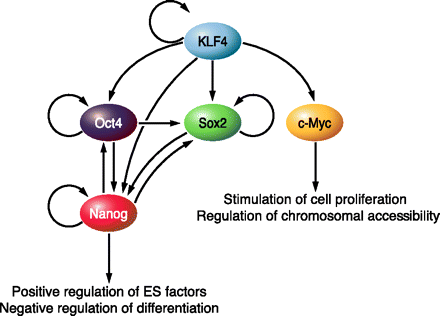Genetics III-Essay assignment
Selama kuliah ini matkul isinya hampir semuanya berkaitan sama DNA dan kawan-kawannya yang saya nggak paham. Rasanya semakin dipelajari semuanya terlihat semakin rumit, apalagi mereka itu nggak gampang bisa dilihat dengan mata jadi seakan semuanya itu cuma teori dan imajinasi dari para peneliti. Tapi memang sekarang ini ya jamannya molekular biologi.
Tulisan di bawah ini salah satu contoh writing assignment di kelas Genetics III, mungkin bisa membantu kalo ada temen-temen yang punya tugas serupa ^^
*****************************************************************************
KLF4 (Kruppel-like factor 4)
The Kruppel-like factor (KLF)
family is a group of zinc finger containing transcription factors, which are
identical with the Drosophila Kruppel protein. The characteristic that
distinguishes the KLF family from other zinc finger containing transcriptional
factors is the presence of three highly conserved C2H2
containing zinc finger motifs at the C terminus. These fingers enable KLFs to
bind to the GC-box or CACCC-boxes on DNA with different affinities.
Kruppel-like
factor 4 (KLF4) is one of the member of the KLF family of transcription factors
and encodes a polypeptide of 483 amino acids. It contains two potent nuclear
localization signals (NLSs), one within the three zinc fingers and the other in
a cluster of basic amino acids immediately adjacent to the first zinc finger.
These two NLSs define a subfamily of three closely related KLFs: KLF1, KLF2,
and KLF4. KLF4 binds to the promoter region of its own gene and can activate
its own transcription and generally can act both as activator and as repressor.
In humans, the protein is encoded by the KLF4 gene. The KLF4 gene is conserved
in drosophila, chimpanzee, Rhesus monkey, dog, cow, mouse, rat, chicken, zebra
fish, and frog.
Figure 1: Structure of KLF4. KLF4 has an N-terminal transcriptional activation domain, followed
by a transcriptional repression domain, containing two lysine residues K225 and
K229. These residues are acetylated by p300/CBP, which interacts with the
activation domain. There lies a potential PEST sequence between the activation
and repression domains. The C-terminus has a DNA binding domain containing
three zinc fingers, which recognize and bind to the GC/CACCC target sequences
in the nucleus. A Nuclear Localization Signal (NLS)
(6 a.a.) is placed between the DNA binding and repression domains, which
facilitates the transport of KLF4 into the nucleus. Please note that the size
of each domain is not exactly proportional. (Hima Vangapandu and Walden Ai,2009)
Expression of the KLF4
gene is developmentally regulated and its higher expression is occurred in the
later stage of fetal development. In adults, KLF4 is highly enriched in
epithelial tissues, including the skin, lung, and intestine. Expression of KLF4
can also be found in a select number of other organs including the testis, thymus,
and in vascular endothelial cells. Forced expression of KLF4 in cultured cells
results in the inhibition of DNA synthesis.
KLF4 regulates proliferation, differentiation
for instance goblet cell differentiation
in the intestine and eye conjunctiva,
apoptosis and somatic cell reprogramming which already proven by Takahashi and
Yamanaka in 2006 that they reprogrammed somatic cells into pluripotent stem
cells using KLF4 in combination with three other transcription factors: Oct4,
Sox2 and c-Myc. It also regulates the
expression of key transcription factors during embryonic development and
maintains embryonic stem cells by inhibiting cell cycle progression. In
addition, KLF4 seems to play a redundant role along with other KLF family
proteins in embryonic stem (ES) cell self-renewal. There are still many other
functions that are owned by KLF4 such as it maintains normal tissue homeostasis
and it acts as a transcriptional activator of
epithelial genes and as a repressor of mesenchymal genes. Evidence also suggests that KLF4
is a tumor suppressor in certain cancers, including colorectal cancer, but
sometimes it can be an oncogene depending on differing cellular context and cancer types.
Figure 2: Multiple context-dependent functions of KLF4. Up
regulation or over expression of KLF4 promotes cell differentiation, inhibits
cell proliferation, and induces cell cycle arrest, down-regulates apoptosis for
maintaining tissue homeostasis. It functions as a tumor suppressor in cancers
of some tissues and as an oncogene in some tissues like those of breast. KLF4
is instrumental in stem cell renewal and generation of induced pluripotent stem
cells (iPS cells). (Hima Vangapandu and Walden Ai,2009)
Figure 3. Both Krüppel-like transcription factor
4 (KLF4) and p21 (also known as CIP1/WAF1) are targets of multiple
tumour-suppressor pathways. KLF4 has been shown to mediate p53–p21
signalling in response to DNA damage23, 62. We speculate that KLF4 is also a
mediator of transforming growth factor-beta (TGFbeta)–p21 and adenomatosis
polyposis coli (APC)–p21 signalling, thereby relaying signals elicited by
multiple key tumour-suppressor pathways. (Benjamin D. Rowland and Daniel S.
Peeper,2006)
Figure 4. Many oncogenic signaling pathways have
contradictory effects, depending on the setting, which allows them to function
as either stimulators or inhibitors of cellular proliferation. (Explanation
only shown that related to KLF4). a | Although Krüppel-like transcription
factor 4 (KLF4) represses transcription of TP53 (the gene that encodes p53),
thereby preventing senescence and inducing resistance to drug-induced
apoptosis, it activates p21 (also known as CIP1/WAF1)-dependent cell-cycle
arrest. d | When KLF4 is expressed in cells that express an activated form of
Ras (RasV12), however, their mutual inhibition of anti-proliferative signaling
results in oncogenic transformation. e | A similar mechanism could occur in
cells that co-express KLF4 and E1A. (Benjamin D. Rowland and Daniel S.
Peeper,2006)
Figure 5. Klf4 as part of a transcriptional
regulatory circuit for somatic cell reprogramming. A model of the
transcriptional hierarchy of the reprogramming transcription factors: Klf4,
Sox2, Oct4, and c-Myc. Klf4 is shown as an upstream regulator of feed-forward
transcription loops; it binds the promoters of Oct4, Sox2, c-Myc, and the
downstream target Nanog. Klfs 2 and 5 can substitute for Klf4 in somatic cell
reprogramming. (Beth B. McConnell and Vincent W. Yang, 2010)
References
Benjamin D. Rowland
and Daniel S. Peeper. KLF4, p21 and context-dependent opposing forces in
cancer. Nature
Reviews Cancer.[Online]2006; 6, 11-23.Available from: http://www.nature.com/nrc/journal/v6/n1/full/nrc1780.html
[Accessed October 25th 2014].
Beth B. McConnell and
Vincent W. Yang. Mammalian Krüppel-Like Factors in Health and Diseases. Physiological Reviews.[Online]2010; (.Available from: 10.1152/physrev.00058.2009 [Accessed November
6th 2014].
Hima Vangapandu and
Walden Ai. Kruppel like factor 4 (KLF4): a transcription factor with diverse
context-dependent functions. Gene Ther Mol Biol. [Online]2009;
194-204.[.Available from: http://www.gtmb.org/pages/13/HTML/17.%20Ai%20et%20al%20194-204.htm [Accessed November 4th 2014].
Kazutoshi Takahashi
and Shinya Yamanaka. Induction of Pluripotent Stem Cells from Mouse Embryonic
and Adult Fibroblast Cultures by Defined Factors. Cell Stem Cell. .[Online]2006;126(4):663-676.Available from: http://dx.doi.org/10.1016/j.cell.2006.07.024
[Accessed November 6th 2014].
Shinya Yamanaka. Strategies and New Developments in the
Generation of Patient-Specific Pluripotent Stem Cells. Cell Stem Cell. [Online]2007;1(1):39-49.Available from: http://dx.doi.org/10.1016/j.stem.2007.05.012
[Accessed November 6th 2014].
Wei Z et al.
Klf4 interacts
directly with Oct4 and Sox2 to promote reprogramming.
Stem Cells. .[Online]2009;
27(12):2969-78.Available from: http://www.ncbi.nlm.nih.gov/pubmed/19816951 [Accessed October 25th 2014].
Ying Shi and Walden Ai. Function of KLF4 in
Stem Cell Biology. Intech.[Online]2013.Available from: 10.5772/54370 [Accessed October 25th 2014].







Comments
Post a Comment